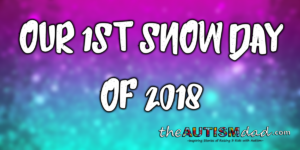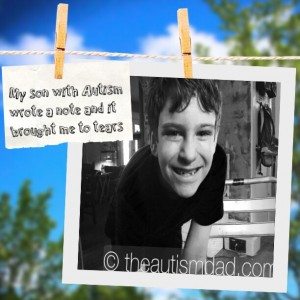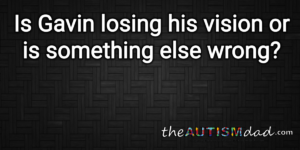What is Autism
Via The Mayo Clinic
Autism spectrum disorder is a serious neurodevelopmental disorder that impairs a child’s ability to communicate and interact with others. It also includes restricted repetitive behaviors, interests and activities. These issues cause significant impairment in social, occupational and other areas of functioning.
Autism spectrum disorder (ASD) is now defined by the American Psychiatric Association’s Diagnosis and Statistical Manual of Mental Disorders (DSM-5) as a single disorder that includes disorders that were previously considered separate — autism, Asperger’s syndrome, childhood disintegrative disorder and pervasive developmental disorder not otherwise specified.
The term “spectrum” in autism spectrum disorder refers to the wide range of symptoms and severity. Although the term “Asperger’s syndrome” is no longer in the DSM, some people still use the term, which is generally thought to be at the mild end of autism spectrum disorder.
The number of children diagnosed with autism spectrum disorder is rising. It’s not clear whether this is due to better detection and reporting or a real increase in the number of cases, or both.
While there is no cure for autism spectrum disorder, intensive, early treatment can make a big difference in the lives of many children.
Symptoms
Autism spectrum disorder impacts how a child perceives and socializes with others, causing problems in crucial areas of development — social interaction, communication and behavior.
Some children show signs of ASD in early infancy. Other children may develop normally for the first few months or years of life, but then suddenly become withdrawn or aggressive or lose language skills they’ve already acquired.
Each child with ASD is likely to have a unique pattern of behavior and level of severity — from low functioning to high functioning. Severity is based on social communication impairments and the restrictive and repetitive nature of behaviors, along with how these impact the ability to function.
Because of the unique mixture of symptoms shown in each child, severity level can sometimes be difficult to determine. However, within the range (spectrum) of symptoms, below are some common ASD actions and behaviors.
Social communication and interaction
- Fails to respond to his or her name or appears not to hear you at times
- Resists cuddling and holding and seems to prefer playing alone — retreats into his or her own world
- Has poor eye contact and lacks facial expression
- Doesn’t speak or has delayed speech, or may lose previous ability to say words or sentences
- Can’t start a conversation or keep one going, or may only start a conversation to make requests or label items
- Speaks with an abnormal tone or rhythm — may use a singsong voice or robot-like speech
- May repeat words or phrases verbatim, but doesn’t understand how to use them
- Doesn’t appear to understand simple questions or directions
- Doesn’t express emotions or feelings and appears unaware of others’ feelings
- Doesn’t point at or bring objects to share interest
- Inappropriately approaches a social interaction by being passive, aggressive or disruptive
Patterns of behavior
- Performs repetitive movements, such as rocking, spinning or hand-flapping, or may perform activities that could cause harm, such as head-banging
- Develops specific routines or rituals and becomes disturbed at the slightest change
- Moves constantly
- May be uncooperative or resistant to change
- Has problems with coordination or has odd movement patterns, such as clumsiness or walking on toes, and has odd, stiff or exaggerated body language
- May be fascinated by details of an object, such as the spinning wheels of a toy car, but doesn’t understand the “big picture” of the subject
- May be unusually sensitive to light, sound and touch, and yet oblivious to pain
- Does not engage in imitative or make-believe play
- May become fixated on an object or activity with abnormal intensity or focus
- May have odd food preferences, such as eating only a few foods, or eating only foods with a certain texture
Most children with ASD are slow to gain knowledge or skills, and some have signs of lower than normal intelligence. Other children with ASD have normal to high intelligence — they learn quickly, yet have trouble communicating and applying what they know in everyday life and adjusting to social situations. A small number of children with ASD are savants — they have exceptional skills in a specific area, such as art, math or music.
As they mature, some children with ASD become more engaged with others and show fewer disturbances in behavior. Some, usually those with the least severe problems, eventually may lead normal or near-normal lives. Others, however, continue to have difficulty with language or social skills, and the teen years can bring worse behavioral problems.
When to see a doctor
Babies develop at their own pace, and many don’t follow exact timelines found in some parenting books. But children with autism spectrum disorder usually show some signs of delayed development within the first year.
If you suspect that your child may have ASD, discuss your concerns with your doctor. The symptoms associated with ASD can also be linked with other developmental disorders. The earlier that treatment begins, the more effective it will be.
Your doctor may recommend developmental tests to identify if your child has delays in cognitive, language and social skills, if your child:
- Doesn’t respond with a smile or happy expression by 6 months
- Doesn’t mimic sounds or facial expressions by 9 months
- Doesn’t babble or coo by 12 months
- Doesn’t gesture — such as point or wave — by 14 months
- Doesn’t say single words by 16 months
- Doesn’t play “make-believe” or pretend by 18 months
- Doesn’t say two-word phrases by 24 months
- Loses previously acquired language or social skills at any age
Causes
Autism spectrum disorder has no single known cause. Given the complexity of the disorder, and the fact that symptoms and severity vary, there are probably many causes. Both genetics and environment may play a role.
- Genetic problems. Several different genes appear to be involved in autism spectrum disorder. For some children, autism spectrum disorder can be associated with a genetic disorder, such as Rett syndrome or fragile X syndrome. For others, genetic changes may make a child more susceptible to autism spectrum disorder or create environmental risk factors. Still other genes may affect brain development or the way that brain cells communicate, or they may determine the severity of symptoms. Some genetic problems seem to be inherited, while others happen spontaneously.
- Environmental factors. Researchers are currently exploring whether such factors as viral infections, complications during pregnancy or air pollutants play a role in triggering autism spectrum disorder.
No link between vaccines and ASD
One of the greatest controversies in autism spectrum disorder is centered on whether a link exists between ASD and certain childhood vaccines, particularly the measles-mumps-rubella (MMR) vaccine. Despite extensive research, no reliable study has shown a link between ASD and the MMR vaccine.
Avoiding childhood vaccinations can place your child in danger of catching and spreading serious diseases, including whooping cough (pertussis), measles or mumps.




